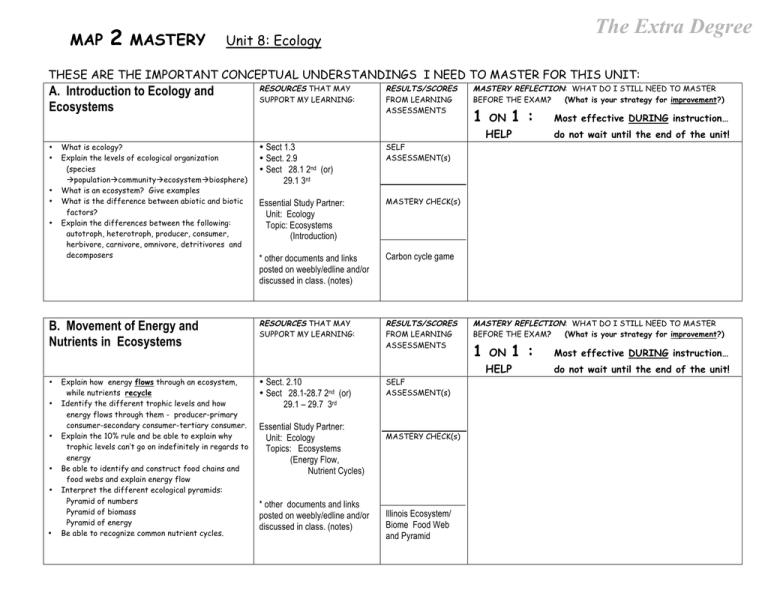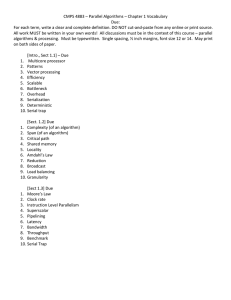The Extra Degree 2 MAP MASTERY
advertisement

MAP 2 MASTERY The Extra Degree Unit 8: Ecology THESE ARE THE IMPORTANT CONCEPTUAL UNDERSTANDINGS I NEED TO MASTER FOR THIS UNIT: A. Introduction to Ecology and Ecosystems RESOURCES THAT MAY SUPPORT MY LEARNING: RESULTS/SCORES FROM LEARNING ASSESSMENTS MASTERY REFLECTION: WHAT DO I STILL NEED TO MASTER BEFORE THE EXAM? (What is your strategy for improvement?) 1 ON 1 : HELP • • • • • What is ecology? Explain the levels of ecological organization (species populationcommunityecosystembiosphere) What is an ecosystem? Give examples What is the difference between abiotic and biotic factors? Explain the differences between the following: autotroph, heterotroph, producer, consumer, herbivore, carnivore, omnivore, detritivores and decomposers B. Movement of Energy and Nutrients in Ecosystems • Sect 1.3 • Sect. 2.9 • Sect 28.1 2nd (or) 29.1 3rd SELF ASSESSMENT(s) Essential Study Partner: Unit: Ecology Topic: Ecosystems (Introduction) MASTERY CHECK(s) * other documents and links posted on weebly/edline and/or discussed in class. (notes) Carbon cycle game RESOURCES THAT MAY SUPPORT MY LEARNING: RESULTS/SCORES FROM LEARNING ASSESSMENTS • • • • • Explain how energy flows through an ecosystem, while nutrients recycle Identify the different trophic levels and how energy flows through them - producer-primary consumer-secondary consumer-tertiary consumer. Explain the 10% rule and be able to explain why trophic levels can’t go on indefinitely in regards to energy Be able to identify and construct food chains and food webs and explain energy flow Interpret the different ecological pyramids: Pyramid of numbers Pyramid of biomass Pyramid of energy Be able to recognize common nutrient cycles. • Sect. 2.10 • Sect 28.1-28.7 2nd (or) 29.1 – 29.7 3rd Essential Study Partner: Unit: Ecology Topics: Ecosystems (Energy Flow, Nutrient Cycles) * other documents and links posted on weebly/edline and/or discussed in class. (notes) SELF ASSESSMENT(s) MASTERY CHECK(s) Illinois Ecosystem/ Biome Food Web and Pyramid do not wait until the end of the unit! MASTERY REFLECTION: WHAT DO I STILL NEED TO MASTER BEFORE THE EXAM? (What is your strategy for improvement?) 1 ON 1 : HELP • Most effective DURING instruction… Most effective DURING instruction… do not wait until the end of the unit! C. Populations and Communities RESOURCES THAT MAY SUPPORT MY LEARNING: RESULTS/SCORES FROM LEARNING ASSESSMENTS MASTERY REFLECTION: WHAT DO I STILL NEED TO MASTER BEFORE THE EXAM? (What is your strategy for improvement?) 1 ON 1 : HELP • Explain the importance of population size, population density, population dispersion and population growth to the characteristics of a population • Explain exponential growth, give examples, and identify conditions that allow for this kind of growth • Explain logistic growth, give examples, and identify conditions that allow for this kind of growth • What is a J curve? S curve? How do these relate to population growth? • What is the carrying capacity of an ecosystem? • What factors influence population growth? • Differentiate between Density-independent factors and Density-dependent factors • Provide examples of each of the above • What is a niche? Give examples • Explain the difference between interspecific and intraspecific competition D. Coevolution and Symbiosis • Section 2.11-2.12 • Sect 29.1-29.3 2nd (or) 30.1 – 30.3 3rd • Sect 29.5-29.8 2nd (or) 30.5 – 30.8 3rd Essential Study Partner: Unit: Ecology Topic: Population (All subsections) 1. Symbiosis/Coevolution • Commensalism • Mutualism • Parasitism 2. Competition 3. Predator/Prey 4. Cooperation • What affect does predation have on competition? • Describe niche and describe its role in competition • Describe exponential and logistical growth models for populations do not wait until the end of the unit! SELF ASSESSMENT(s) MASTERY CHECK(s) * other documents and links posted on weebly/edline and/or discussed in class. (notes) RESOURCES THAT MAY SUPPORT MY LEARNING: RESULTS/SCORES FROM LEARNING ASSESSMENTS MASTERY REFLECTION: WHAT DO I STILL NEED TO MASTER BEFORE THE EXAM? (What is your strategy for improvement?) 1 ON 1 : HELP • Be able to give examples and recognize each of the ecological relationships studied in this class and their various forms: Most effective DURING instruction… • Sect 29.9-29.12 2nd (or) 30.9 – 30.12 3rd SELF ASSESSMENT(s) • Sect 29.15 2nd (or) 30.15 3rd Essential Study Partner: Unit: Ecology Topic: Communities (Introduction, Organization) *other documents and links posted on weebly/edline and/or discussed in class. (notes) MASTERY CHECK(s) Most effective DURING instruction… do not wait until the end of the unit!



